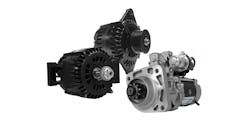“This approach will reduce emissions without imposing crippling new costs that will hurt construction firms and their workers.” –Stephen Sandherr, CEO, Associated General Contractors of America.
It’s a novel approach, to say the least: requiring state highway contracts not only to require diesel emissions reductions from any and all equipment used on such jobs, but covering the cost of retrofitting or repowering equipment to meet emissions standards.
Will it work, however? That remains to be seen – but, in a most unlikely marriage, the Associated General Contractors of America (AGC) and the non-profit Clean Air Task Force (CATF) are jointly calling on Congress to give state officials both the authority and funding to require use of clean construction equipment at federally-funded transportation projects.
“This is a great opportunity to clean up many of the millions of older diesel engines still in use,” said Conrad Schneider, CATF’s advocacy director. “We are standing side-by-side with the contractors on this.”
Basically, the two groups are calling for emission reductions from any big highway projects to be achieved by contract change orders that cover 100% of the cost for contractors – following the award of a project to the lowest bidder, of course – and are also espousing what they call a set of “Clean Construction Principles” to help guide this process.
Under these “principles,” states would first require successful bidders for federally-funded transportation projects to identify the off-road diesel equipment they plan to use at the job site. After exploring Environmental Protection Agency-approved options for reducing diesel emissions, states would issue change orders requiring contractors to pursue the best of those options – with said change orders entitling contractors to recover 100% of their equipment retrofit costs. Also, states would give priority to such “clean construction” projects located in areas with poor air quality.
Now, where would the money come from to fund such retrofits? Both groups are recommending that Congress set aside a significant portion of the funds historically provided for Congestion Mitigation and Air Quality (CMAQ) programs, and/or an appropriate percentage of other funds that the relevant legislation authorizes Congress to appropriate for surface transportation projects.
It’s an ambitious effort, no doubt – and it may go nowhere with a Congress so absorbed with an attempted legislative overhaul of healthcare industry in the U.S. that even transportation funding is getting short shrift these days. But it’s an interesting tactic to try, nonetheless.



